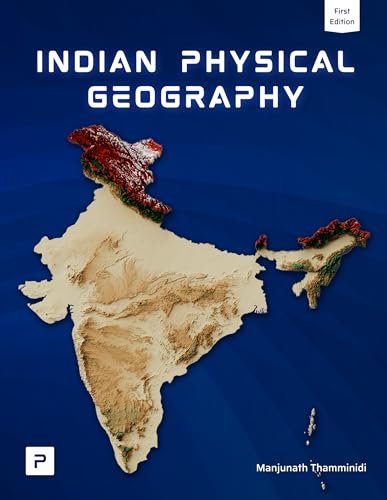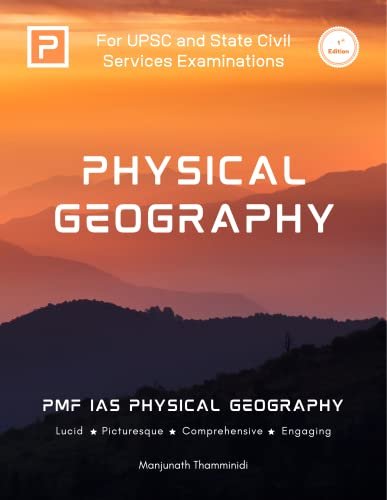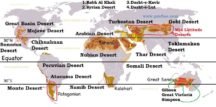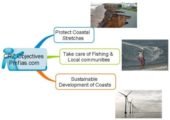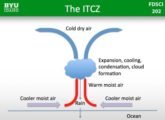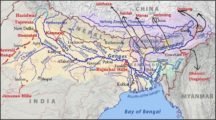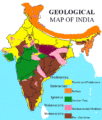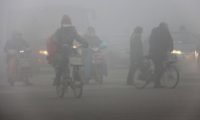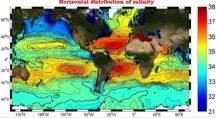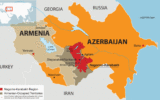
Richter Magnitude Scale & Earthquakes of Varying Strengths
Subscribe to Never Miss an Important Update! Assured Discounts on New Products!
Must Join PMF IAS Telegram Channel & PMF IAS History Telegram Channel
Last updated on April 17, 2024 7:20 PM
Richter Magnitude Scale
- Charles F. Richter developed the Richter magnitude scale (ML) for measuring the strength (amount of energy released) of earthquakes in 1930s.
- Because of the various shortcomings of the ML scale, seismologists now use moment magnitude scale (Mw).
- Both the scales are logarithmic and are scaled to have roughly comparable numeric values.
- Moment magnitude scale Mw scale is now generally referred to as the Richter scale.
- Under the Richter magnitude scale, an increase of one step corresponds to about 32 times increase in the amount of energy released, and an increase of two steps corresponds to 1,000 times increase in energy.
- Thus, an earthquake of Mw of 7.0 releases about 32 times as much energy as one of 6.0 and nearly 1,000 times (~ 32 X 32) one of 5.0.
- Richter scale is only effective for regional earthquakes no greater than M5. Moment magnitude scale is more effective for large earthquakes.
Earthquakes of Varying Strengths
|
Magnitude |
Description |
Average earthquake effects |
Frequency of occurrence |
| 1.0–1.9 | Micro |
|
Several million per year |
| 2.0–2.9 | Minor |
|
Over one million per year |
| 3.0–3.9 |
|
Over 100,000 per year | |
| 4.0–4.9 | Light |
|
10,000 to 15,000 per year |
| 5.0–5.9 | Moderate |
|
1,000 to 1,500 per year |
|
6.0–6.9 |
Strong |
|
100 to 150 per year
|
|
7.0–7.9 |
Major |
|
10 to 20 per year
|
|
8.0–8.9 |
Great |
|
One per year
|
|
9.0 and greater |
|
One per 10 to 50 years
|
Based on U.S. Geological Survey documents
Most powerful earthquakes ever recorded
| Event | Mw | Focus | ||
| 1 | 1960 Valdivia earthquake | 9.4–9.6 | 33 km |
|
| 2 | 1964 Alaska earthquake | 9.2 | 25 km |
|
| 3 | 2004 Indian Ocean earthquake | 9.1–9.3 | 30 km |
|
| 4 | 2011 Tōhoku earthquake | 9.1 | 30 km |
|
Notable Earthquakes
| Event | Magnitude | Notes |
| 1556 Shaanxi earthquake | 8.0 | Deadliest earthquake with 8,00,000+ fatalities
Most of the deaths were caused due to the collapse of artificial caves carved into the loess cliffs |
| 2011 Tōhoku earthquake and tsunami | 9.1 | Costliest earthquake that caused damage to property worth $250 billion |
| 1819 Rann of Kutch earthquake | 7.7 to 8.2 | It triggered a tsunami and caused more than 1000 deaths
The earthquake caused an area of subsidence that formed the Sindri Lake and a local zone of uplift to the north about 80 km long, 6 km wide and 6 m high that dammed the several rivers. This natural dam was known as the Allah Bund (Dam of God). |
| 2001 Gujarat earthquake (Focus: 24 km) | 7.7 | The earthquake killed between 13000 and 20000 people |
- The Gujarat quake occurred 400 km to the south-east of the tectonic boundary separating Indian Plate and the Eurasian Plate.
- The current tectonics is governed by the effects of the continuing continental collision along this boundary.
- The collision has reactivated the original rift faults and development of new thrust faults in the region.
- The pattern of uplift and subsidence associated with the 1819 Rann of Kutch earthquake is consistent with reactivation of such faults.
- The area saw many minor earthquakes in the 20th Century including the 2001 earthquake.
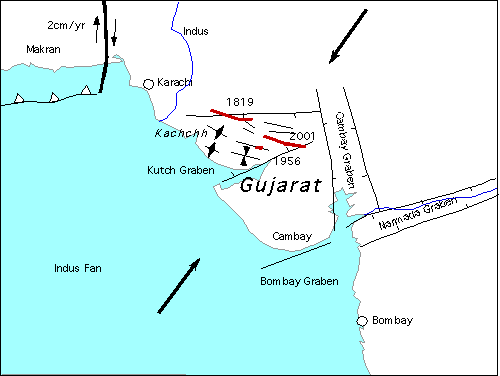
Earthquake zones of India
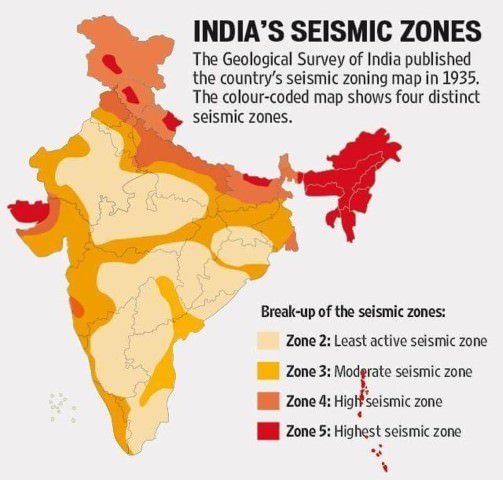
Earthquake zones of India (Source)
- The latest seismic zone map prepared by the National Disaster Management Authority reveals that nearly 59% of India’s land area is prone to moderate or severe earthquakes.
- This earthquake zoning map divides India into five different zones of earthquake intensity and highlights the location that falls under them.
Effects of Earthquakes
Shaking and ground rupture
- Shaking and ground rupture result in severe damage to buildings and other rigid structures.
- Ground rupture (crack along the fault) is a major risk for large engineering structures such as dams, bridges and nuclear power stations.
Landslides and avalanches
- Earthquakes, along with severe storms, volcanic activity, coastal wave attack, and wildfires, can produce slope instability leading to landslides, a major geological hazard.
Fires
- Earthquakes can cause fires by damaging electrical power or gas lines.
- More deaths in the 1906 San Francisco earthquake were caused by fire than by the earthquake itself.
Soil liquefaction
- Soil liquefaction occurs when water-saturated soil temporarily loses its strength and transforms from a solid to a liquid. Soil liquefaction may cause rigid structures, like buildings and bridges, to tilt or sink.
Tsunami
- Megathrust earthquakes can produce long-wavelength, long-period sea waves due to abrupt movement of large volumes of water.
Floods
- Floods may be secondary effects of earthquakes if dams are damaged.
- Earthquakes may cause landslips to dam rivers, which collapse and cause floods.
Last updated on April 17, 2024 7:20 PM





